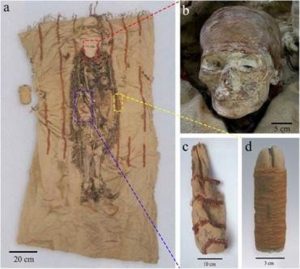Archaeologists led by Yang Yimin of University of Chinese Academy of Sciences in Beijing found wooden carvings of male genitals found in the hands of female mummies in graves at the Xiaohe Tomb complex in Lop Nur, Xinjiang (China’s Uyghur autonomous region). The wooden artefacts measured 4 centimetres in length and were found in the grip of 4000-year-old female mummies. Wooden replicas of genitalia were found in the left hand of almost every female at the tomb complex. The females also carried leather bags attached to the right side of their waists, which included “sticks” made of hematite powders. The mummies also had red lines painted on the forehead.

The finds were painted red to highlight their sacred status. The tomb complex ranks as one of the largest and oldest burial sites in the world for mummies. The bronze-age burial site dates back to 1980BC, houses around 330 tombs, and contains more than 30 well-preserved mummies. The content of a typical female tomb in Xiaohe cemetery includes a leather bag on the right side of the waist (purple box), wooden replica genitalia and a wooden comb under buttocks.

(after South China Morning Post)